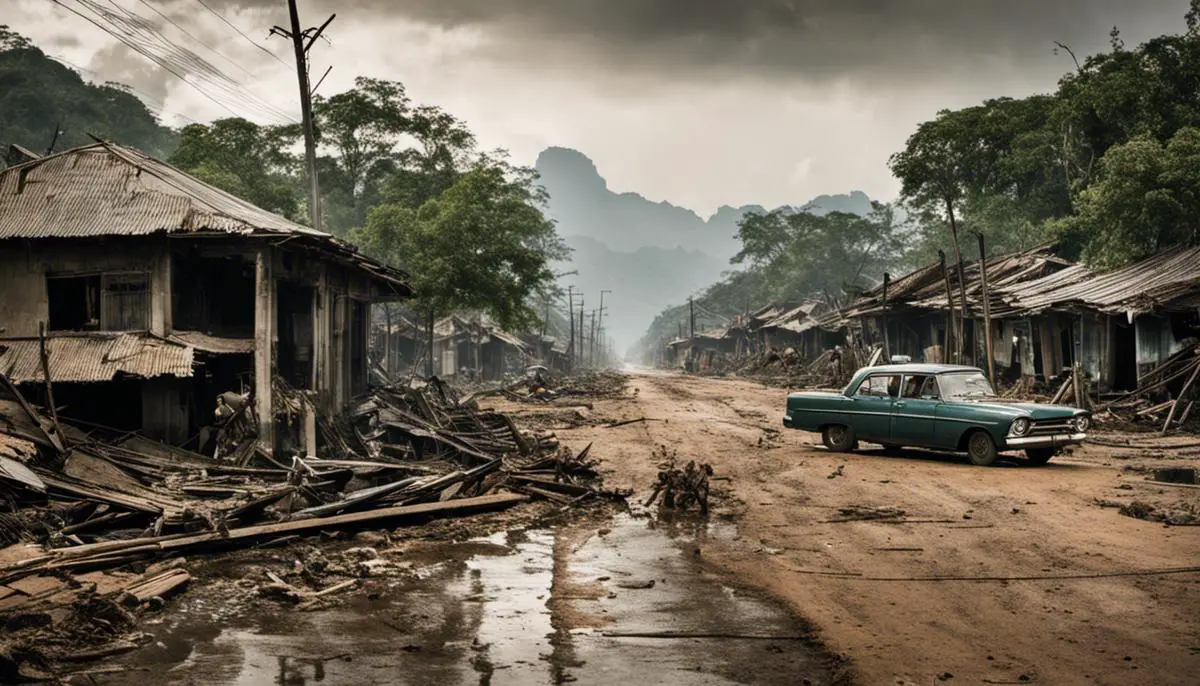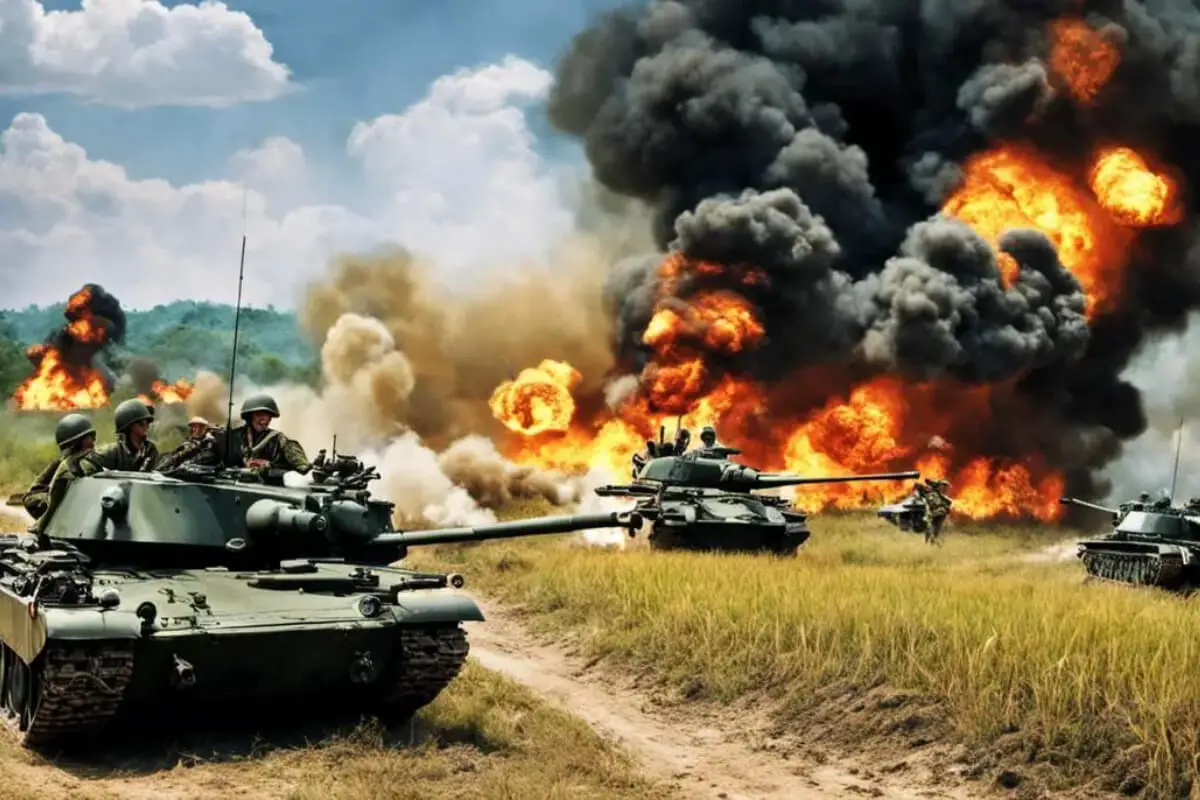In the annals of 20th-century history, the Vietnam War emerged as one of the most complex and contentious conflicts ever to alter the geopolitical landscape. As an amalgam of intricate power dynamics, shifting allegiances, expansive battles, and profound aftermaths, the Vietnam War is a subject area that invites profound study.
By exploring the contextual origins enhanced by political, social, and economic narratives, we equip ourselves with the necessary lens to understand the looming shadows of this war. With many vital stakeholders directing and influencing the war’s trajectory, an analysis of their affiliations and impacts can provide crucial insights into the overall conflict and its repercussions. An in-depth examination of critical battles and turning points can further illuminate the strategic and symbolic significance of these militaristic engagements.
Table of Contents
- Historical Context Of The Vietnam War
- Key Players And Stakes In The Conflict
- Major Battles And Turning Points
- Impact And Aftermath Of The War
- Interpretation And Legacy
- Vietnam, bearing the brunt of the war’s relentless onslaught, was shattered to its core.
- The human health implications of this sustained environmental assault were profound.
- Post-war Vietnam also underwent significant sociopolitical shifts.
- Simultaneously, the United States grappled with its brand of post-war ramifications.
- From an economic perspective, the war unleashed an inflationary nemesis.
- A significant impact was exerted upon the men and women on the frontlines.
- Related Questions
Historical Context Of The Vietnam War
Title: Tracing the Historical Context of the Vietnam War and its Impact on the Conflict’s Course
The Vietnam War, fought from November 1, 1955, to April 30, 1975, represents an enduring historical puzzle, especially when seen through the lens of context and the way this context arguably shaped its course.
This conflict is invariably examined through a confluence of social, political, and economic circumstances prevalent not only in Vietnam but also in the larger international arena.
The underlying causes of the Vietnam War may be traced back to the late 19th century, specifically to French colonialism in Indochina, a region comprising what are now Vietnam, Laos, and Cambodia.
After a booming nationalist movement post-World War II, led by Ho Chi Minh, the region experienced sporadic French control. Eventually, it succumbed to a protracted struggle for independence, culminating in the Geneva Conference in 1954.
Geopolitical context played a substantial role in the conflict. The aftermath of the Second World War had seen the global polity bifurcate into two ideologically opposed blocs—capitalism, led by the United States, and communism, led by the Soviet Union.
In this Cold War environment, the Domino Theory—the belief that if one state in a region came under the influence of communism, then the surrounding countries would follow—shaped U.S. foreign policy and their involvement in Vietnam.
In essence, the Vietnam War was essentially a proxy war acting as a containment strategy by the U.S. against what was perceived as an expansionist communist Soviet Union. Consequently, the U.S. sent troops to support the newly formed South Vietnam against the communist North Vietnam, marking a direct U.S. intervention.
Coupled with this, societal factors such as civil rights and counterculture movements in the United States played an immense role in influencing public opinion, both domestically and overseas.
Anti-war protests and dissent were widespread, leading to policy changes and affecting the execution strategy of the war, demonstrating the excruciating social and political cost of the conflict.
Economically, the burden of the war fundamentally affected not only the American economy, causing inflation and budget deficits, but also the global economic landscape. It contributed to the end of the Bretton Woods system as the U.S. abandoned the gold standard in 1971, fundamentally reshaping the world’s economic order.
In conclusion, understanding the interplay between various historical contexts—colonial history, geopolitical climate, societal movements, or the economic situation—is indispensable in comprehending the course and consequences of the Vietnam War.
The war, a complex mix of local and global factors, ultimately reflects an intricate web of historical context and conflict evolution. Through such in-depth exploration, we are offered a granular understanding of not just the war itself but the broader implications of global history during this era.

Key Players And Stakes In The Conflict
In delineating an account of the stakeholders in the Vietnam War, let us begin with the obvious yet often overlooked geopolitical entity: the Republic of Vietnam, alternatively known as South Vietnam.
Under the sure leadership of figures such as Ngo Dinh Diem and Nguyễn Văn Thiệu, South Vietnam was a bulwark against the infiltration of communism in the Southeast Asian region. The leadership, however, was not without its set of complexities.
With a government largely influenced by Buddhists and a military possessing considerable clout, there existed an inherent tension and power struggle within the Republic.
Next in line, but not any less significant, was the Democratic Republic of Vietnam, more commonly known as North Vietnam, which Ho Chi Minh headed. The North Vietnamese were entrenched in their communist ideology, aided and driven by the impetus of the Soviet Union and communist China.
The war acted as a conduit for extending their ideological reach into the South, thereby consolidating a unified Vietnam under a single ideology.
It becomes crucial here to mention the Viet Cong. Regarded as the southern arm of North Vietnam’s resilient communist thrust, this was an insurgent group of communist guerrillas who shunned not only foreign intervention but also the anti-communist policies of South Vietnam.
Their unique underground tunnel systems and guerilla tactics brought a fresh set of challenges for the enemy combatants.
The United States’ involvement in this geopolitical spectacle mirrored their more significant commitment to “containing communism.” They viewed a unified, communist Vietnam as a potential domino that could tip other Southeast Asian countries into the lap of communism, thereby extending the ideological reach of their Cold War rivals, the Soviet Union. Warfare in Vietnam, thus, was perceived as a just mechanism through which to stem this ideological diffusion.
The Soviet Union, a prominent player in its own right, posited a tactical counter-force to the United States, using Vietnam as a proxy battlefield. They provided a substantial portion of the military aid that North Vietnam received, effectively escalating the intensity of the conflict while avoiding direct involvement.
Exerting a considerable influence from the periphery was the People’s Republic of China. While sharing an ideological platform with North Vietnam, China’s involvement in the Vietnam War is understood in the framework of nuanced geopolitical powerplay, specifically the Sino-Soviet split. It is a testament to China’s role that their reduction in aid to North Vietnam, following better U.S.-China ties in the early 1970s, significantly altered the course of the war.
Australia and New Zealand, as well, were key players in the Vietnam conflict. Pledged to the defense of the deteriorating situation in Southeast Asia, these nations provided significant military support to the United States under the aegis of the Southeast Asia Treaty Organization (SEATO).
This intricate interplay between national, local, and foreign entities in this conflict gives a holistic analytical view of the Vietnam War as more than a two-sided battle. It was a multi-faceted conflict that shaped history, ultimately highlighting the pervasive global implications of ideology, power, and agency.
Major Battles And Turning Points
The exploration of the significant battles in the Vietnam War and their influence in shaping the course and outcomes of the conflict reveals the profound complexities and nuances of this historical event.
Two key turning points were the Tet Offensive of 1968 and the Easter Offensive of 1972, which played significant roles in altering the trajectory of the war, influencing international opinion, and shaping the eventual end of the conflict.
The Tet Offensive, executed in January 1968, was a surprise campaign launched by the Viet Cong (V.C.) and North Vietnamese Army (NVA) against multiple targets in South Vietnam. Despite the United States and South Vietnamese forces managing to repel these attacks, the psychological impact of the offensive was far-reaching.
It exposed the vulnerability of claimed secure areas, subverted the persistent optimistic narrative promulgated by U.S. military officials, and initiated a more profound evaluation of the U.S. involvement in Vietnam. The televised coverage of the Tet Offensive served to fuel anti-war sentiment, intensifying pressure on the Johnson administration to seek a resolution to the conflict.
The Easter Offensive, initiated by the NVA in 1972, further intensified the uncertainty and divisiveness surrounding the United States’ involvement in Vietnam. Although technically a tactical victory for South Vietnam and the United States forces, the sheer scale of the offensive revealed the capability and resolve of the North Vietnamese forces.
Occurring the same year as planned peace talks in Paris, the offensive significantly influenced these negotiations. The urgency imposed by the offensive informed the U.S. willingness to make significant concessions to expedite the ending of the conflict, including recognition of the VC-led provisional revolutionary government.
Conversely, the Battle of Hamburger Hill, which occurred in May 1969, although relatively less known, is noteworthy for its long-lasting repercussions on U.S. military strategy and public sentiment towards the war. Despite achieving a tactical win, the substantial loss of life led to increased questioning of U.S. leadership and the broader military goals in Vietnam.
The public outrage and political controversy that ensued caused substantial shifts in policy away from attrition warfare and towards Vietnamization, which sought to increase South Vietnamese responsibility for military actions.
Similarly, the Battle of Khe Sanh, unfolding concurrently with the initiation stages of the Tet Offensive, challenged U.S. perceptions of victory conditions. The 77-day siege, though culminating in U.S. forces retaining Khe Sanh Combat Base, illustrated the severity of battlefield conditions, fortifying NVA resolve and, crucially, diverting tactical focus away from unfolding Tet Offensive initiatives.
These key battles illustrate the profound complexities and the dynamic interplay between military, political, and public perception factors that defined the Vietnam War. They highlight the intricate weave of tactical circumstances, strategic decisions, and their profound imprints on the public psyche, altering the pace and trajectory of U.S. involvement in the ill-fated Vietnam conflict.

Impact And Aftermath Of The War
Pivoting onward in our exploration of the aftermath of the Vietnam War in the United States and Vietnam, the impact appears both immediate and longstanding, prominently illustrated in the swathes of physical, emotional, societal, and political repercussions.
In the aftermath of the war, Vietnam experienced extensive damage to its infrastructure. This was evident in both urban and rural landscapes, with ravaged cities, decimated villages, obliterated roads, and shattered bridges.
This condition not only impeded the mobility of people and goods, but it assailed the very heart of societal functionality. The impact on agriculture was severe, a significant concern given the agricultural foundation of Vietnam’s economy. Winograd asserts that approximately 15 million acres of farmland were destroyed due to bombardments and chemical warfare, leaving the countryside barren and unproductive.
The environmental toll was monumental, with the use of defoliants like Agent Orange resulting in vast forest decimation and alarming wildlife depletion. This had severe knock-on effects on the country’s biodiversity and ecosystem health.
The persistent health impacts on the Vietnamese populace have proven manifold. Documentations by Warwick indicate an uptick in numerous complicated health conditions, including cancers, congenital disabilities, and other debilitating illnesses, often attributed to residual dioxin exposure, a potent component of Agent Orange.
Turning to the sociopolitical aspects, the end of the Vietnam War marked the start of a unified, communist Vietnam. This shift brought significant changes in sociopolitical structures and ideologies. A comprehensive land reform program was implemented, with land redistribution generally favoring poor farmers.
However, the collective farm policy that followed faced massive resistance, leading to administrative challenges and food production crises. The years following 1975 saw hundreds of thousands of “boat people” fleeing political repression and economic situations, marking one of the largest diasporas in modern history.
Within the United States, the Vietnam War shaped an era of significant societal and political transformation. As Morphett elucidates, the war ignited widespread anti-war sentiment, leading to an increasingly skeptical society questioning the government’s decisions, transparency, and integrity.
This skepticism contributed to what political scientists coin as the “Vietnam Syndrome,” a collective societal and political reluctance to engage in foreign wars without guaranteed quick and definitive victory.
Economically, the Vietnam War intensified inflationary pressures, ultimately leading to the ‘stagflation’ that marked the American economy in the 1970s. Equally, the war proved costly in human terms, with over 58,000 American soldiers killed and many more physically and psychologically wounded. The immense human toll sparked an evolution in medical and psychiatric practices and broadened the understanding of traumatic stress disorders.
Moreover, the Vietnam War was a fundamental factor underlying the relative decline of American global influence in the subsequent years. The war revealed the limitations of American power, tarnishing its international reputation and drawing amplified scrutiny to future foreign interventions.
Searching through the annals of history, the relics of the Vietnam War are deeply ingrained in the fabric of both Vietnam and the United States, the implications permeating every facet of life.
The narrative of the Vietnam War aftermath is more than mere chapters in a book or numbers in a data set; it continues to resonate in the lives of millions, serving as a stark reminder of the horrors of war and the enduring imperfections of human diplomacy and decision making.

Interpretation And Legacy
The narrative of the Vietnam War traced in its sheer intensity and stunning complexity, harbored myriad impressions over time—each one an unerring tribute to its indelible aftermath.
Yet, beyond the immaculate specifics of battle lines and political stakes, the magnitude of its long-term consequences extends far more profound than mere numbers or statistics.
This examination will delve into some of the critical legacies of the Vietnam War, honing on the environmental, socioeconomic, and psychological dimensions that continue to reverberate years out from its cessation.
Vietnam, bearing the brunt of the war’s relentless onslaught, was shattered to its core.
Its prosperous landscape was transformed into a grim tableau of destruction.
Particularly devastating was the extensive damage inflicted upon the country’s agriculture—an economic staple that once thrived amidst the rich expanse of the Mekong Delta—leaving in its wake a staggering toll on biodiversity, altered ecosystems, and displaced wildlife populations.
Instances of infertile farmlands and degraded soil were symptoms of a larger environmental epidemic, provoked in part by the pervasive use of chemical defoliants like Agent Orange.
The human health implications of this sustained environmental assault were profound.
With increased incidents of cancer, neurological disorders, congenital disabilities, and post-traumatic stress disorder (PTSD), the physical and psychological toll on Vietnamese citizens was substantial, embedding a haunting legacy in the very fabric of the nation’s being.
Post-war Vietnam also underwent significant sociopolitical shifts.
One such metamorphosis was the bitter-sweet advent of land reform—a move to redistribute agricultural land from landowners to farmers, uprooting societal hierarchies and spurring novel socioeconomic dynamics.
Moreover, the “boat people” diaspora, prompted by an escape from repressive communist regimes, precipitated a significant migration wave—adding yet another layer to the rich quilt of the war’s long-lasting imprint.
Simultaneously, the United States grappled with its brand of post-war ramifications.
Defeat in Vietnam led to the propagation of an intense anti-war sentiment, leaving a populace disillusioned with the traditional pillars of governance and leadership—ripples of which can still be felt in contemporary societal critiques.
From an economic perspective, the war unleashed an inflationary nemesis.
Feeding the war machine led to an incremental surge in public spending, casting an inevitable monkey wrench into well-oiled domestic socio-economic machinery.
The fiscal aftershocks of war outlived the bullets and bombs, exacerbating disparities and planting seeds of financial discord.
A significant impact was exerted upon the men and women on the frontlines.
The human toll of the Vietnam War upon American soldiers underscored not just physical but also psychological scars.
The advent of PTSD amongst veterans necessitated advancements in psychiatry, leading in part to enhanced recognition and treatment of trauma-induced conditions.
Last but not least, the war marked the downward trajectory of America’s global influence.
The defeat resonated across international corridors, diminishing the potency of America’s perceived invincibility and unilaterally altering the paradigms of international relations.
In conclusion, the legacy of the Vietnam War is a labyrinthine web of environmental, socio-political, and human ramifications—with reverberations echoing far beyond the geographical boundaries of Vietnam, permeating global consciousness at an unprecedented scale.
The interpretation of this war continues to morph over temporal canvases, embodying a living, breathing testament to an unforgettable era of history.

As we retrospectively engage with the layers of the Vietnam War, the different interpretations and enduring legacies of this massive conflict become increasingly apparent. Over time, these perspectives have morphed, shaped by societal transformations, political transitions, and academic revelations.
What truly stands out is the persisting imprint of the war on popular culture and its inextricable link to the present understanding of international relations and conflict studies.
The Vietnam War, with its psychological, physical, political, and economic repercussions, continues to resonate globally and serve as a constant reminder of the implications of warfare on a nation and the world at large.
At A Bus On A Dusty Road, we talk about history, travel, life, sailing, and ex-pat living. We are all about “Living Life As A Global Citizen.” We explore social, cultural, and economic issues and travel.
We would love to have you be part of our community. Sign up for our newsletter to keep up-to-date by clicking here. If you have any questions, you can contact me, Anita, by clicking here.
Listen to our Podcast called Dusty Roads. You can find it on all major podcast platforms. Try out listening to one of our podcasts by clicking here.
Subscribe to our A Bus On A Dusty Road YouTube Channel with great videos and information by clicking here.
Related Questions
What U. S Companies Profited During The Vietnam War?
During the Vietnam War, many U.S. companies profited from the Vietnam war. Some of these companies were heading toward bankruptcy, but their involvement in the Vietnam war helped make them profitable. For many others, they earned millions of dollars each year in profits from the war that helped ensure they continued to be successful or even thriving companies.
By clicking here, you can discover What U. S Companies Profited During The Vietnam War?
Could America Have Won The Vietnam War?
America could not have won the Vietnam war as it never won the hearts and minds of the Vietnamese people. The Americans even had difficulty controlling the Vietnamese people in Southern Vietnam, as many were disillusioned with the Southern Vietnamese government. Ho Chi Minh, the leader of North Vietnam, fully understood that another foreign power would not control the Vietnamese heart and soul.
By clicking here, you can discover Could America Have Won The Vietnam War?
What Was The Main Reason For US Involvement In Vietnam?
The main reason for the involvement of the United States in the Vietnam War was the belief in the Domino theory; the Domino theory was a principle used to describe the effects on the world if Vietnam fell to communism. The idea was that if Vietnam became communist, the rest of Asia, New Zealand, and Australia would eventually become communist. At the time, American leaders felt they were fighting for the survival of democracy throughout the world.
By clicking here, you can learn more by reading What Was The Main Reason For U.S. Involvement In Vietnam?

